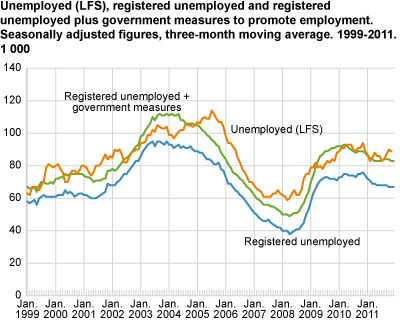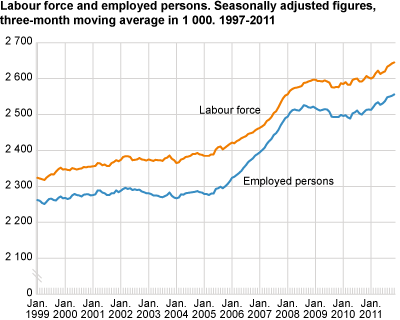Content
Published:
This is an archived release.
Employment up by 46 000
The growth from the 4th quarter of 2010 to the 4th quarter of 2011 among employed women was made up of part-time workers, whereas the growth among men was made up of full-time workers.
A large proportion of the growth in employment happened within construction and within human health and social work activities. This might explain the difference in the development among women and men. Men working full-time dominate the first industry, while women working part-time dominate the latter. In the 4th quarter of 2011, 86 per cent of employed men and 59 per cent of women were working full-time.
Continued stable labour force participation
From the 4th quarter of 2010 to the 4th quarter of 2011, the population aged 15-74 increased by 63 000 persons. The increase came in the form of 46 000 more employed persons, 5 000 less unemployed persons and 22 000 more persons outside the workforce. The labour force participation (employed + unemployed) rate was 71.3 per cent; approximately the same as a year earlier.
Seasonally-adjusted figures: increased employment and stable unemploymentAdjusted for seasonal variations, the number of employed persons increased by 7 000 from the 3rd quarter to the 4th quarter of 2011. The increase is within the margin of error. The unemployment rate was 3.4 per cent of the labour force in the 4th quarter of 2011. The increase from 3.2 per cent in the 3rd quarter is also within the margin of error. Adjustments for seasonal variations allow for the analysis of underlying developments in the labour market. Seasonally-adjusted figures are presented in a separate article . The rest of the figures in this article are not seasonally adjusted. |
Increase in employment within construction
The number employed in construction increased by 15 000 persons between the 4th quarter of 2010 and the same quarter of 2011. There was also an increase in employment in this industry in the other quarters of 2011 compared to the corresponding quarters of 2010. In line with an even longer trend, the number of employed persons within human health and social work activities increased by 18 000 from the 4th quarter of 2010 to the 4th quarter of 2011. There was a simultaneous reduction of 7 000 employed persons within accommodation and food services activities.
One third of the unemployed are long-term unemployed
From the 4th quarter of 2010 to the same quarter of 2011, the number of unemployed decreased by 5 000. The decrease among the unemployed was among those who had been unemployed for 3 months or less. This means that the inflow of new unemployed persons was reduced during that period. Of the 80 000 unemployed in the 4th quarter of last year, 25 000 were long-term unemployed. Long-term unemployed is defined as those who have been out of work for more than 26 weeks.
Less underemployed women
Underemployment is defined as employees with a contract for part-time work who have tried to find more work. Of the 62 000 who were underemployed in the 4th quarter of last year, 47 000 were women. Compared to the 4th quarter of 2010, the number of underemployed women had decreased by 4 000. The underemployed as a share of all part-time employed was 9 per cent in the last quarter of 2011, down 1 percentage point from the previous year.
The time the underemployed wanted to work extra in the 4th quarter of 2011 corresponded to 23 000 full-time jobs. Adding the time that the unemployed wanted to work that quarter, the work wanted by these two groups corresponded to 91 000 full-time equivalents - down 7 000 from the year before.
|
The labour force is the sum of employed and unemployed between 15-74 years of age. From the 4th quarter of 2010 to the 4th quarter of 2011, the LFS shows that the employment rose by 46 000 persons and the unemployment fell by 5 000 persons. This gives an increase in the labour force of 41 000 persons. In the same period, the population increased by 63 000 persons, so the labour force participation rate remained stable. Coherence between the conceptsUnemployed + Employed = Labour force Labour force + Outside the labour force = Population |
Tables:
- Table 1. Population aged 15-74, by labour force status (LFS) and sex 1 000
- Table 2. Population aged 15-74, by labour force status (LFS) and sex. Changes from the same period in the previous year. 1 000
- Table 3. Population aged 15-74, by labour force status(LFS) and sex. Per cent
- Table 4. Persons in the labour force and employed persons aged 15-74, by age and sex (LFS). 1 000
- Table 5. Persons in the labour force and employed persons aged 15-74, by age and sex (LFS). In per cent of the population
- Table 6. Persons aged 15-74, employed by contractual/usual working hours per week and unemployed, by age and sex (LFS). 1 000
- Table 7. Persons in the labour force aged 15-74, by age and sex (LFS). 1 000
- Table 8. Persons in the labour force aged 15-74, by age and sex (LFS). As per cent of all in each group
- Table 9. Employed persons aged 15-74, by sex and contractual/usual working hours per week (LFS). 1 000
- Table 10. Population aged 15-74, by main activity, part-time employment and age (LFS). 1 000
- Table 11. Employed persons aged 15-74, by major industry division (LFS). 1 000
- Table 12. Average number of man-weeks worked (37,5 hours), by industry division (LFS). 1 000
- Table 13. Employed persons aged 15-74, and average number of man-weeks worked (a 37.5 hours) per week, by sex and status. 1 000. Actual working hours, by sex and status. Hours per week
- Table 14. Employed persons aged 15-74 and absence from work during the whole reference week, by reason for absence and sex (LFS). 1 000
- Table 15. Employed persons aged 15-74 and absence from work during the whole reference week, by reason for absence and sex (LFS). Per cent
- Table 16. Employees aged 15-74 with temporary jobs, by major industry division (LFS). 1 000
- Table 17. Employees aged 15-74 with temporary jobs, by major industry division (LFS). In per cent of all employees
- Table 18. Unemployed persons aged 15-74, by sex and age (LFS). 1 000 and per cent
- Table 19. Unemployed persons aged 15-74, by duration of job search (LFS).1 000 and per cent
- Table 20. Unemployed persons aged 15-74, by main activity (LFS). 1 000
- Table 21. Unemployed and underemployed persons aged 15-74, by sex and desired working hours per week. Number of man-weeks (of 37,5 hours) supplied (LFS). 1 000
- Table 22. Employed persons aged 15-74, by sex and region of residence (LFS). 1 000
- Table 23. Employed persons aged 15-74, by sex and region of residence (LFS) as per cent of all inn each group
Contact
-
Arbeidsmarked og lønn
E-mail: arbeidsmarked@ssb.no
-
Erik Herstad Horgen
E-mail: erik.horgen@ssb.no
tel.: (+47) 93 08 68 62
-
Håvard Hungnes Lien
E-mail: havard.lien@ssb.no
tel.: (+47) 40 90 26 06


